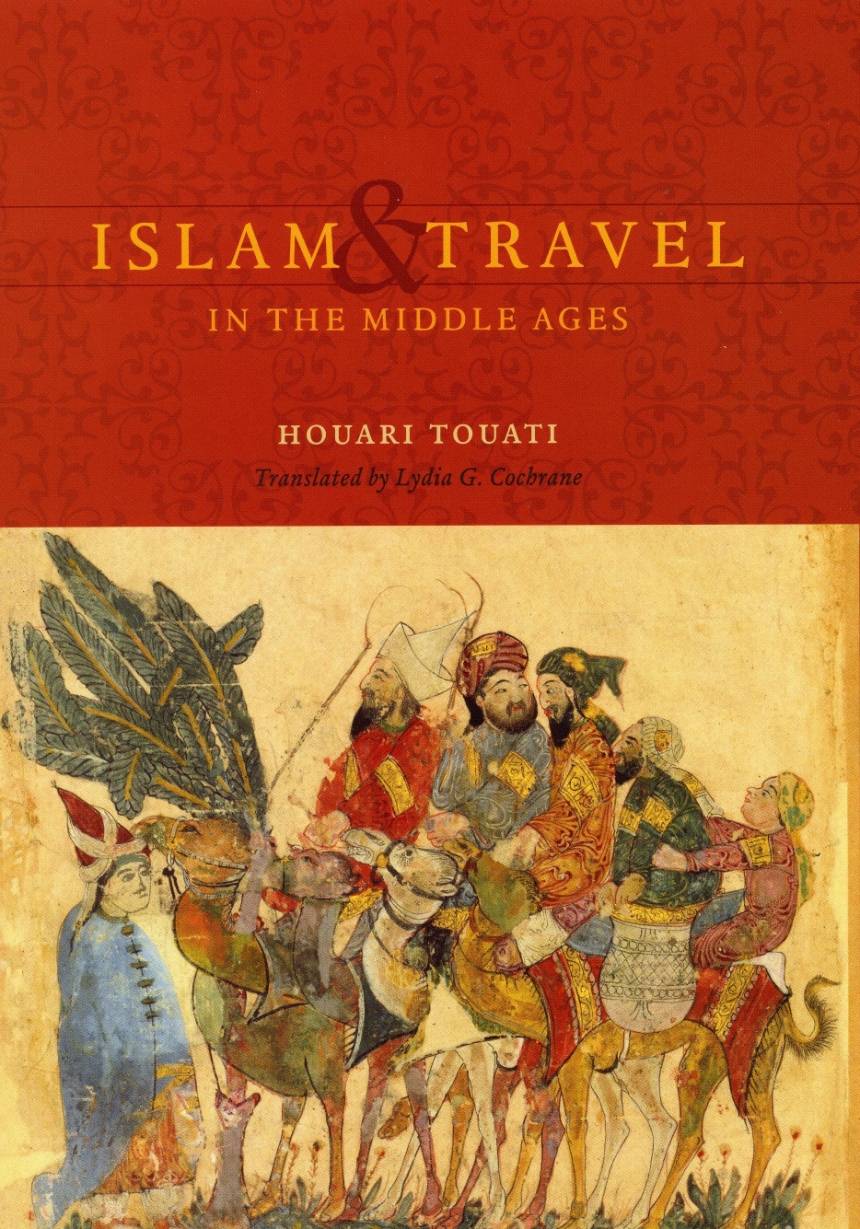

Islam and Travel in the Middle Ages
Houari Touati
In the Middle Ages, Muslim travelers embarked on a rihla , or world tour, as surveyors, emissaries, and educators. On these journeys, voyagers not only interacted with foreign cultures—touring Greek civilization, exploring the Middle East and North Africa, and seeing parts of Europe—they also established both philosophical and geographic boundaries between the faithful and the heathen. These voyages thus gave the Islamic world, which at the time extended from the Maghreb to the Indus Valley, a coherent identity.
Islam and Travel in the Middle Ages assesses both the religious and philosophical aspects of travel, as well as the economic and cultural conditions that made the rihla possible. Houari Touati tracks the compilers of the hadith who culled oral traditions linked to the prophet, the linguists and lexicologists who journeyed to the desert to learn Bedouin Arabic, the geographers who mapped the Muslim world, and the students who ventured to study with holy men and scholars. Travel, with its costs, discomforts, and dangers, emerges in this study as both a means of spiritual growth and a metaphor for progress. Touati’s book will interest a broad range of scholars in history, literature, and anthropology.
304 pages | 1 map | 6 x 9 | © 2010
Geography: Cultural and Historical Geography
History: Middle Eastern History
Literature and Literary Criticism: Classical Languages
Medieval Studies
Middle Eastern Studies
Religion: Islam
- Table of contents
- Author Events
Related Titles
“Much learning supports Touati’s book, which gives us a richer sense of the driving forces behind travel in the Islamic Middle Ages than we have had before.”
Francis Robinson | Times Literary Supplement
“This is an elegant work of exploration and synthesis, linking Greek analysis of the sensorium to Muslim debates concerning the priority of seeing over hearing. The range of original sources from Islamic civilization is stunning, including medieval litterateurs from al-Jāhiz to al-Bīrūnī to Ibn Khallikān. Travel as both experience and metaphor, practice and trope, is illumined here by Touati in cogent vignettes that engage—and advance—current debates about knowledge, its acquisition, its soundness, and its permeable boundaries. No other book like it exists in the library of scholarship on Islam and the Muslim world.”
Bruce B. Lawrence, Duke University
“Many of us appreciate the unique importance of travel and exile for Islamic literature and thought. In English, however, we have had nothing to rival Touati’s Islam and Travel in the Middle Ages , with its subtle, original argument, its elegant style, and its wide and profound coverage of original sources. Touati brings together a rich variety of topics and themes, with an underlying epistemological distinction—between ‘audition’ and ‘eyewitnessing’—that informed the experience of Muslim travelers and their literary output. We are fortunate to have this fluent, precise English translation.”
Michael Bonner, University of Michigan
“ Islam and Travel in the Middle Ages considers travel from an unorthodox and engaging perspective—not as a question of commerce, transportation, or engineering, but as conceptual category, intellectual quest, and epistemological value. By thoughtful engagement with Arabic texts of various genres, including but by no means limited to travelogues, Touati shows how knowledge was acquired, valued, packaged, and disseminated, as well as the categories by which it was conceived and defined. The publication of this work in French revealed a noticeable gap in our synthetic understanding of the voyage as both a mode of knowledge and a means for the production of knowledge in medieval Islamicate societies; it has now been enhanced in this painstaking English translation.”
Franklin D. Lewis, University of Chicago
“Elegantly written, superbly documented, and imaginative in scope and analysis, this erudite and interesting book is the definitive account of how travel in Islam was knowledge, practice, combat, image, and absence.”
Brannon Wheeler, United States Naval Academy
Table of Contents
Preface to the English-Language Edition (2010)
Acknowledgments (2000)
Introduction
Chapter 1: Invitation to the Voyage
The ‘ilm , an Onomastic Emblem
A Catastrophic Theory of Knowledge
The Genealogical Structure of Knowledge
Chapter 2: The School of the Desert
Linguists and Bedouins
The Stay in the Desert
A Geography of Pure Language
A Theory of the Stay in the Desert
Chapter 3: The Price of Travel
Financing a Voyage
Paying a Personal Price
Terminus
Chapter 4: Autopsy of a Gaze
The Eye of the Popeyed Man
A Geographer in His Study
The Experience of the Voyage
A Clinical Look at Muslim Verismo
Muqaddasi, Strabo, and Greek Science
Chapter 5: Attaining God
The Theory of the Errant Life
Topographical Writing
Sufism as a Crossing of the Desert
The Voyage to Syria
Entering into the Desert
Society and Its Obverse
Chapter 6: Going to the Borderlands
The Ulemas and Jihad
An Ideology of Combat
Jihad and Hagiography
Chapter 7: Writing the Voyage
Narrating an Absence
The Extraordinary in the Voyage
The Travel Letter
An Art of Travel
A Return to the Travel Narrative
Conclusion: The Journey to the End of the Same
Chronological List of Principal Travel Accounts
Bibliography
Al-Ghazali’s "Moderation in Belief"
Reading darwin in arabic, 1860-1950.
Marwa Elshakry
Knot of the Soul
Stefania Pandolfo
Mullahs on the Mainframe
Jonah Blank
Article Contents
- < Previous
Houari Touati Islam and Travel in the Middle Ages . Translated by Lydia G.Cochrane. Chicago: University of Chicago Press. 2010. Pp. ix, 305. $55.00.
- Article contents
- Figures & tables
- Supplementary Data
Olivia Remie Constable, Houari Touati Islam and Travel in the Middle Ages . Translated by Lydia G.Cochrane. Chicago: University of Chicago Press. 2010. Pp. ix, 305. $55.00., The American Historical Review , Volume 116, Issue 5, December 2011, Page 1607, https://doi.org/10.1086/ahr.116.5.1607
- Permissions Icon Permissions
In this eye-opening study of medieval Islamic travel (translated from the French original, Islam et voyage au Moyen Âge [2000]), Houari Touati argues that the scope and intent of this travel created the conceptual boundaries of the Muslim world, or Dār al-Islām. Through their movements, travelers defined “a political, religious, and cultural space” (p. 38), and thus travel was “one of Islam's major intellectual acts” (p. 265). Early Muslim travelers ventured forth in search of knowledge, journeying widely to gather information about Islamic traditions and other religious data from far-flung scholars. Touati tracks the development of the travel genre, from its beginnings in the eighth and ninth centuries as inventories listing the scholars consulted along the way, through the tenth-century forms of letter, journal, and geographical treatise, to the full-fledged rihla narrative of the twelfth century.
Touati focuses on travelers whose voyages had religious motives and intellectual consequences. His survey of travel literature is selective, though extensive, illuminating the voyages of men who journeyed far afield to listen to the words of religious scholars, who ventured into the desert to study the pure forms of Bedouin Arabic, who enhanced geographical knowledge, and who spent time on the Islamic frontiers. Because the origins of Muslim travel were rooted in collecting knowledge about Islam, these travelers rarely ventured beyond the boundaries of Muslim lands. Nevertheless, they had an extensive geographical range, as their voyages took them from Spain to India, and there was plenty of opportunity for adventure, hardship, intellectual experience, and religious growth. Touati's focus on travel within the confines of the Muslim world excludes certain other types of traveler, such as diplomats, merchants, and captives, who moved beyond the borders of the Dār al-Islām. Likewise, Touati's prioritization of travelers with an intellectual rationale avoids discussion of the best-known form of Muslim travel, the pilgrimage to Mecca.
Much of Touati's argument is structured around the concepts of acquiring information through hearing (“audition”; French: audition ) and seeing for oneself (“autopsia”; autopsie ). Touati envisions two models for Islamic travel narratives, one drawing data from listening to language and Islamic tradition (“I come, I listen, and I write”) and the other giving priority to sight and eyewitness (“I go, I see, and I write”) (p. 255). This epistemological division is reflected in the organization of chapters in the book, which first give attention to the collection of auditory information through travel to study with hadīth transmitters or to listen to Bedouin Arabic, then go on to discuss geographical and mystical accounts that emphasize visual data and sights personally witnessed by the author. This conceptualization is illuminating and brings new insights to the development of the travel genre. Unfortunately, semi-invented English words like “autopsia” (glossed as “knowledge through sight” [p. 269]) can impede straightforward comprehension. One wonders why the already slightly odd French autopsie was not simply translated into English as “eyewitness,” or perhaps more fittingly, denoted with either the Arabic mushāhada (“seeing with one's own eyes” [p. 271]) or 'iyān (“direct visual knowledge” [p. 270]).
One especially suggestive aspect of Touati's discussion draws attention to the ways in which the objectives of medieval Islamic travel differed from those of European travel. Touati argues that Western travel was often focused outward, beyond the borders of Europe, and thus travel accounts gave priority to encounters with “the other.” In contrast, because of the nature of the intellectual rationale for their voyages, Muslim travelers moved within the confines of the Dār al-Islām, and had relatively little interest in what lay beyond. This insight provides an intriguing new explanation for why medieval Muslim travelers almost never went to Europe, while European Christians readily ventured into the Islamic world. Nevertheless, there are some problems with Touati's evidence, and more investigation is needed to solidify the comparison. For example, most of his European evidence is late medieval or early modern, from Marco Polo onward, whereas his Arabic sources are mainly pre-thirteenth century. This lack of chronological parallelism enhances the impression of an outward-looking Europe and an inward-looking Muslim world.
The English translation carefully follows the French original, although in places its precision hinders comfortable reading. Besides “autopsia,” one finds other strained cognates such as “vivificator” (p. 24; vivificateur ) or “the auditioned person” ( l'auditionné ), meaning a person to whom one has listened (p. 97). New in the English version are citations to English translations of Arabic texts, where available. Curiously, the glossaries of the French and English editions are strikingly different. One serious issue that exists in both editions is the lack of citations for several quotations (e.g., pp. 74, 89, 93, 137, and 219). It is surprising that this grave omission was not corrected in the English version.
Email alerts
Citing articles via.
- Editorial Board
- Author Guidelines
- Recommend to your Library
Affiliations
- Online ISSN 1937-5239
- Print ISSN 0002-8762
- Copyright © 2024 The American Historical Association
- About Oxford Academic
- Publish journals with us
- University press partners
- What we publish
- New features
- Open access
- Institutional account management
- Rights and permissions
- Get help with access
- Accessibility
- Advertising
- Media enquiries
- Oxford University Press
- Oxford Languages
- University of Oxford
Oxford University Press is a department of the University of Oxford. It furthers the University's objective of excellence in research, scholarship, and education by publishing worldwide
- Copyright © 2024 Oxford University Press
- Cookie settings
- Cookie policy
- Privacy policy
- Legal notice
This Feature Is Available To Subscribers Only
Sign In or Create an Account
This PDF is available to Subscribers Only
For full access to this pdf, sign in to an existing account, or purchase an annual subscription.
Department of History
Week 4. religious travel in the global middle ages.
Pilgrimage, proselytising, and religious study have been major factors for human mobility throughout history, and were both cause and consequence of the intense trans-regional connectivity characterising the "Global Middle Ages". Involving people of different genders and social backgrounds, religious travel is a feature common to each of the world's major religious traditions. In this seminar we will compare the experiences and writings of Jewish, Muslim, Christian, and Buddhist travellers as a means to examine different types of historical records of travel, the types of information they provide, and the various approaches that can be used to study them.
Core Readings (pick two)
Martin Jacobs, '"A Day's Journey": Spatial Perceptions and Geographic Imagination in Benjamin of Tudela's Book of Travels', The Jewish Quarterly Review 109.2 (2019), pp. 203-232. Link .
Michael Gomez, African Dominion: A New History of Empire in Early and Medieval West Africa (Princeton, NJ: Princeton University Press, 2018), pp. 104-125. Link .
Saeko Kimura, 'Regeneration Narratives: The Confessions of Lady Nijō as a Story for Women's Salvation', Review of Japanese Culture and Society 19 (2007), pp. 87-102. Link .
Primary Sources (pick two)
Whalen, Brett Edward (ed.), Pilgrimage in the Middle Ages: A Reader (Toronto: University of Toronto Press, 2011), pp. 23-26 (Etheria); pp. 280-284 (Benjamin of Tudela); pp. 285-295 (Rabban Sauma); pp. 304-308 (Mansa Musa). Link
Tabish Khair, Martin Leer, Justin D. Edwards, and Hanna Ziadeh (eds.), Other Routes: 1500 Years of African and Asian Travel Writing (Bloomington, IN: Indiana University Press, 2005), pp. 71-75 ('The Pilgrimages of Lady Nijô (b. 1271)'). Link .
Seminar preparation
1. The three secondary readings each represent a different approach to studying travel. Synthesize the approach of the articles you've read in a sentence or two. What accounts for their differences? Which holds the greatest appeal for you and why?
2. Different primary sources lend themselves to different kind of questions. What kind of information and insights can be obtained from the sources you picked? Why is this relevant?
Seminar Questions
- How does Jacobs situate his approach to Benjamin of Tudela’s account historiographically? How might you use his article for a historiographical essay?
- What is the nature of “real and imagined geography” (p. 223) in Benjamin of Tudela’s account? How useful do you find the distinction for analysing travel narratives?
- Was Mansā Mūsā’s hajj primarily religious or political in nature? Why?
- In what ways does Mansā Mūsā’s hajj shed light on wider social, political, and economic conditions? Which do you find most suggestive in thinking about travel history, and why?
- “A man is more of less free to travel eastward or even to China, but there are so many hindrances for a traveling woman that I understand it to be impossible.” (Emperor Go-Fukakusa to Lady Nijō, c. 1300). How does (religious) travel intersect with gender?
- How do Lady Nijō’s Confessions offer an alternative view on (religious) travel?
Further Reading
Adler, Elkan Nathan (ed.), Jewish Travellers (New York: Routledge, 1930). Link .
Buswell, Robert E. 'Korean Buddhist Journeys to Lands Worldly and Otherworldly' The Journal of Asian Studies 68.4 (2009), pp. 1055-1075. Link .
Campbell, Mary Baine, 'Medieval Travel Writing (1): Peregrinatio and Religious Travel Writing', in: Nandini Das and Tim Youngs (eds.), The Cambridge History of Travel Writing (Cambridge: Cambridge University Press, 2019), 33-47. Link .
Chareyron, Nicole, Donald Wilson (trans.), Pilgrims to Jerusalem in the Middle Ages (New York: Columbia University Press, 2005). Link .
Coleman, Simon, and John Elsner, Pilgrimage: Past and Present in the World Religions (Cambridge, MA: Harvard University Press, 1997). Library .
Craig, Leigh Ann, Wandering Women and Holy Matrons: Women as Pilgrims in the Later Middle Ages (Leiden and Boston: Brill, 2009). Link .
Eastmond, Antony, Tamta's World: The Life and Encounters of a Medieval Noblewoman from the Middle East to Mongolia (Cambridge: Cambridge University Press, 2017). Link .
Eickelman, Dale F., and James P. Piscatori (eds.), Muslim Travellers: Pilgrimage, Migration, and the Religious Imagination (London: Routledge, 1990). Link .
Gordon, Stewart, When Asia was the World: Traveling Merchants, Scholars, Warriors and Monks Who Created the "Riches of the East" (Philadelphia: Da Capo Press, 2008). Link .
Gosch, Stephen S., and Peter N. Stearns, Premodern Travel in World History (New York: Routledge, 2008), Ch. 5 'Buddhist Journeys, 400-900 CE' and Ch. 7 'Muslim Travelers, 700-1400 CE'. Link .
Hargett, James, Stairway to Heaven: A Journey to the Summit of Mount Emei (Albany: State University of New York Press, 2006). [Primary source] Link .
Hargett, James, 'What Need is There to Go Home? Travel as a Leisure Activity in the Travel Records (Youji 游記) of Su Shi 蘇軾 (1037–1101)', The Chinese Historical Review 23.2 (2016), pp. 111-129. Link .
Hayden, Judy A., and Nabil Matar (eds.), Through the Eyes of the Beholder: The Holy Land, 1517-1713 (Leiden and Boston: 2013). Link .
Hermans, Erik, A Companion to the Global Middle Ages (Leeds: Arc Humanities Press, 2020). Link .
Jacobs, Martin, Reorienting the East: Jewish Travelers to the Medieval Muslim World (Philadelphia: University of Pennsylvania Press, 2014). Link .
Khanmohamadi, Shirin A., In Light of Another's Word : European Ethnography in the Middle Ages (Philadelphia, PA: The University of Pennsylvania Press, 2014), pp. 57-87. Link .
Le Beau, Bryan F., and Menachem Mor (eds.), Pilgrims & Travelers to the Holy Land (Omaha: Creighton University Press, 1996).
Legassie, Shane Aaron, The Medieval Invention of Travel (Chicago: University of Chicago Press, 2017).
Morère, Nuria, 'Antiquity in Benjamin of Tudela’s Travel Narrative: Interpretation and Meaning within the Context of the History of Travel', Journal of Tourism History 9.1 (2017), pp. 27-43. Link .
Netton, Ian Richard (ed.), Islamic and Middle Eastern Geographers and Travellers (4 vols. London: Routledge, 2008).
Ohler, Norman, Caroline Hiller (trans.), The Medieval Traveller (Woodbridge: Boydell, 1989).
Peters, F.E., The Hajj: the Muslim Pilgrimage to Mecca and the Holy Places (Princeton, NJ: Princeton University Press, 1994), Ch. 3: 'The Medieval Hajj (1100-1400 C.E.)'. Link .
Phillips, Kim M., Before Orientalism: Asian Peoples and Cultures in European Travel Writing, 1245-1510 (Philadelphia, PA: The University of Pennsylvania Press, 2013). Link .
Romano, John (ed.), Medieval Travel and Travelers: A Reader (Toronto: University of Toronto Press, 2020). [Primary source excerpts] Link .
Rossabi, Morris, Voyager from Xanadu: Rabban Sauma and the first journey from China to the West (Berkeley, CA: University of California Press, 2010) Link .
Shalev, Zur, 'Benjamin of Tudela, Spanish Explorer', Mediterranean Historical Review 25.1 (2010), pp. 17-33. Link .
Touati, Houari, trans. Lydia G. Cochrane, Islam and Travel in the Middle Ages (Chicago: University of Chicago Press, 2010).
Wriggins, Sally Hovey, The Silk Road Journey with Xuanzang (Boulder, CO: Westview Press, 2004). Link .


Sign Up Today
Start your 14 day free trial today

The History Hit Miscellany of Facts, Figures and Fascinating Finds
9 Key Muslim Inventions and Innovations of the Medieval Period

Richard Bevan
04 jan 2022.

From the 8th century to around the 14th century, the medieval world witnessed what is known as the Islamic Golden Age. During this time, Muslims across the Middle East, North Africa and Europe pioneered swathes of cultural, social and scientific inventions and innovations.
The lives of human beings around the globe today would be quite different without the contributions of these medieval Muslim thinkers and inventors. Hospitals, universities, coffee and even the predecessors of modern violins and cameras, for example, were all pioneered during the Islamic Golden Age.
Here are 9 Muslim inventions and innovations of the medieval period.
Yemen is where the ubiquitous dark bean brew has its origins from around the 9th century. In its early days, coffee assisted Sufis and Mullahs to stay up during late nights of religious devotion. It was later brought to Cairo in Egypt by a group of students.
By the 13th century, coffee had reached Turkey, but it wasn’t until 300 years later that the drink, in its various forms, began to be brewed in Europe. It was first brought to Italy, now famously associated with quality coffee, by a Venetian trader.
2. The flying machine
Although Leonardo Da Vinci is associated with early designs for flying machines , it was Andalusian-born astronomer and engineer Abbas ibn Firnas who first constructed a flying device, and technically flew it, in the 9th century. Firnas’ design consisted of a winged apparatus made of silk that fitted around a man like a bird costume.
During a botched flight trial in Cordoba, Spain, Firnas managed to briefly fly upwards before falling back to the ground and partially breaking his back. But his designs may have been an inspiration for Leonardo hundreds of years later.

The word algebra comes from the title of the 9th-century book Kitab al-Jabra , by Persian mathematician and astronomer Muhammad ibn Musa al-Khwarizmi. The pioneering work translates as a tome of reasoning and balancing by the man who became known as the ‘father of algebra’. Al-Khwarizmi was also the first individual to introduce the mathematical concept of raising a number to a power.
4. Hospitals
What we now view as modern centres of health – providing medical treatments, training and study – first emerged in 9th-century Egypt. The very first medical centre is thought to have been constructed in Cairo in 872 by Ahmad ibn Tulun, the ‘Abbasid governor of Egypt’.
Ahmad ibn Tulun Hospital, as it is known, provided free care for all – a policy based on the Muslim tradition of caring for anyone who was sick. Similar hospitals spread from Cairo around the Muslim world.
5. Modern optics
Around the year 1000, the physicist and mathematician Ibn al-Haytham proved the theory that humans see objects by light reflecting off them and entering the eye. This radical view went against the established theory at the time that light was emitted from the eye itself and pioneered centuries of scientific study into the human eye.
Al-Haytham also invented the ‘camera obscura’, a device that forms the basis of photography and explained how the eye sees images upright due to the connection between the optic nerve and the brain.

Muslim polymath Al-Ḥasan Ibn al-Haytham.
Image Credit: Public Domain
Born in 936, court physician Al Zahrawi, from southern Spain, published a 1,500 page illustrated encyclopaedia of surgery techniques and tools titled Kitab al Tasrif . The book went on to be used as a medical reference tool in Europe for 500 years. Alongside his surgical investigations, he developed surgical tools for C-sections and cataract surgeries and invented a device to safely crush kidney stones.
Over a 50-year career, he investigated gynaecology issues, performed the first tracheotomy operation and studied eyes, ears and noses in great detail. Zahrawi also discovered the use of dissolving threads to stitch wounds. Such an innovation did away with the need for a second surgery to remove sutures.
7. Universities
The first university in the world was the University of al-Qarawiyyin in Fez, Morocco. It was founded by Fatima al-Fihri, a Muslim woman from Tunisia. The institution first emerged as a mosque in 859, but later grew into the al-Qarawiyyan mosque and university. It still operates 1200 years later and is a reminder that learning is at the core of the Islamic tradition.

8. The crank
The hand-operated crank is thought to have first been used in ancient China. The device led to the emergence, in 1206, of the revolutionary crank and connecting rod system, which converted rotary motion into a reciprocating one. First documented by Ismail al-Jazari, a scholar, inventor and mechanical engineer in what is now Iraq, it assisted with the lifting of heavy objects with relative ease, including the pumping of water up a crankshaft.
9. Bowed instruments
Among many instruments that arrived in Europe through the Middle East are the lute and the Arabian rabab, the first known bowed instrument and an ancestor of the violin, which was played widely in Spain and France in the 15th century. Modern musical skills are also said to have derived from the Arabic alphabet.

A rabab, or Berber ribab, a traditional Arabic instrument.
Image Credit: Shutterstock
You May Also Like

The Royal Mint: Oliver Cromwell’s Depiction as a Roman Emperor

The Royal Mint: Edward VIII’s Unreleased Coins

A Timeline of Feudal Japan’s ‘Nanban’ Trade with Europeans

Mac and Cheese in 1736? The Stories of Kensington Palace’s Servants

The Peasants’ Revolt: Rise of the Rebels


10 Myths About Winston Churchill

Medusa: What Was a Gorgon?

10 Facts About the Battle of Shrewsbury

5 of Our Top Podcasts About the Norman Conquest of 1066

How Did 3 People Seemingly Escape From Alcatraz?

5 of Our Top Documentaries About the Norman Conquest of 1066

1848: The Year of Revolutions
- Architecture and Design
- Asian and Pacific Studies
- Business and Economics
- Classical and Ancient Near Eastern Studies
- Computer Sciences
- Cultural Studies
- Engineering
- General Interest
- Geosciences
- Industrial Chemistry
- Islamic and Middle Eastern Studies
- Jewish Studies
- Library and Information Science, Book Studies
- Life Sciences
- Linguistics and Semiotics
- Literary Studies
- Materials Sciences
- Mathematics
- Social Sciences
- Sports and Recreation
- Theology and Religion
- Publish your article
- The role of authors
- Promoting your article
- Abstracting & indexing
- Publishing Ethics
- Why publish with De Gruyter
- How to publish with De Gruyter
- Our book series
- Our subject areas
- Your digital product at De Gruyter
- Contribute to our reference works
- Product information
- Tools & resources
- Product Information
- Promotional Materials
- Orders and Inquiries
- FAQ for Library Suppliers and Book Sellers
- Repository Policy
- Free access policy
- Open Access agreements
- Database portals
- For Authors
- Customer service
- People + Culture
- Journal Management
- How to join us
- Working at De Gruyter
- Mission & Vision
- De Gruyter Foundation
- De Gruyter Ebound
- Our Responsibility
- Partner publishers

Your purchase has been completed. Your documents are now available to view.
Travel and Exploration in the Middle Ages
From the book volume 3.
- Romedio Schmitz-Esser
- X / Twitter
Supplementary Materials
Please login or register with De Gruyter to order this product.
Chapters in this book (19)

Flannels or FlipFlops
Step Back in Time at These Ancient European Castles!
Posted: June 28, 2024 | Last updated: June 28, 2024

There’s something magical about visiting real medieval castles– connecting to history and seeing how royalty lived. It’s like a Disney movie come to life! Europe is brimming with these majestic palaces, some hundreds of years old, that you can still visit and see up close.
You can walk through the same halls, explore the same towers, and imagine the Kings and Queens who lived there throughout the Middle Ages. Some of these castles date back to the 11th century and have been built, preserved, and maintained surprisingly well for their age.
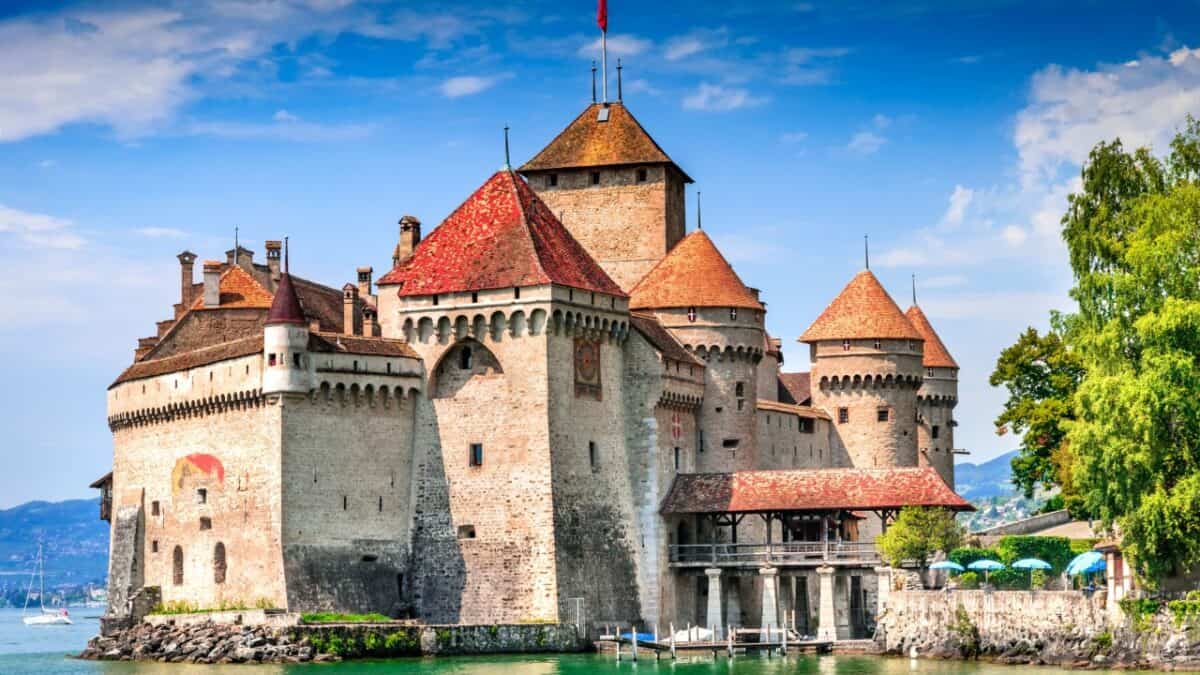
1. Château de Chillon
Château de Chillon sits on a tiny island on Lake Geneva in Switzerland, right between the gorgeous towns of Montreux and Villeneuve. Built in the 11th century, it evolved from a humble fort into a grand castle guarding a key trade route. Explore the grand halls, spooky dark dungeons, and even a chapel.
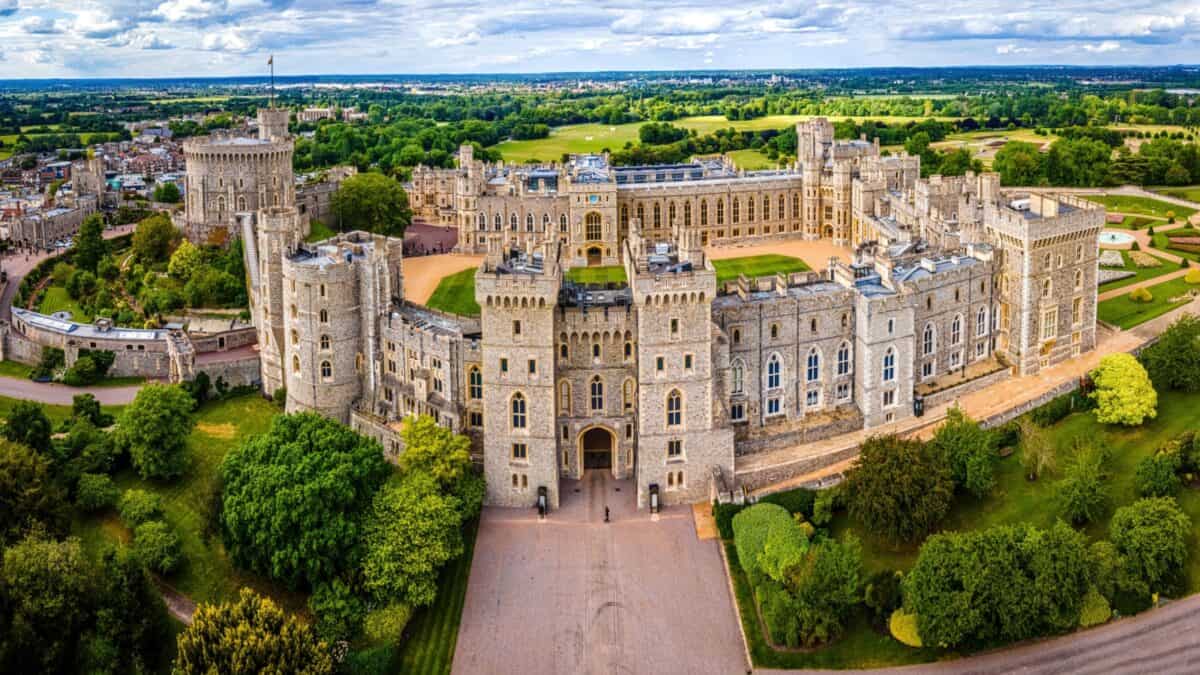
2. Windsor Castle
If you’re a die-hard fan of the British royal family, don’t miss Windsor Castle, constructed in the 11th century for William the Conqueror. It’s one of the longest-occupied castles in the world, housing royalty from Henry I’s reign starting in 1100 up to present-day King Charles III. Located in charming Windsor, near London, it’s a favorite weekend getaway for British kings and queens and is open to visitors year-round.

3. Hohenwerfen Fortress
Hohenwerfen Fortress is a real-life fairytale castle perched atop a cliff overlooking an enchanting Austrian town. Its roots date back to 1077, and it has served as a fortress, prison, hunting lodge, and even a film set for Where Eagles Dare , starring Clint Eastwood.
Nestled among the trees at 623 meters high, it offers breathtaking views of the Salzach Valley and surrounding mountains. Open from April to November , the castle welcomes visitors with extended hours in the peak summer months.
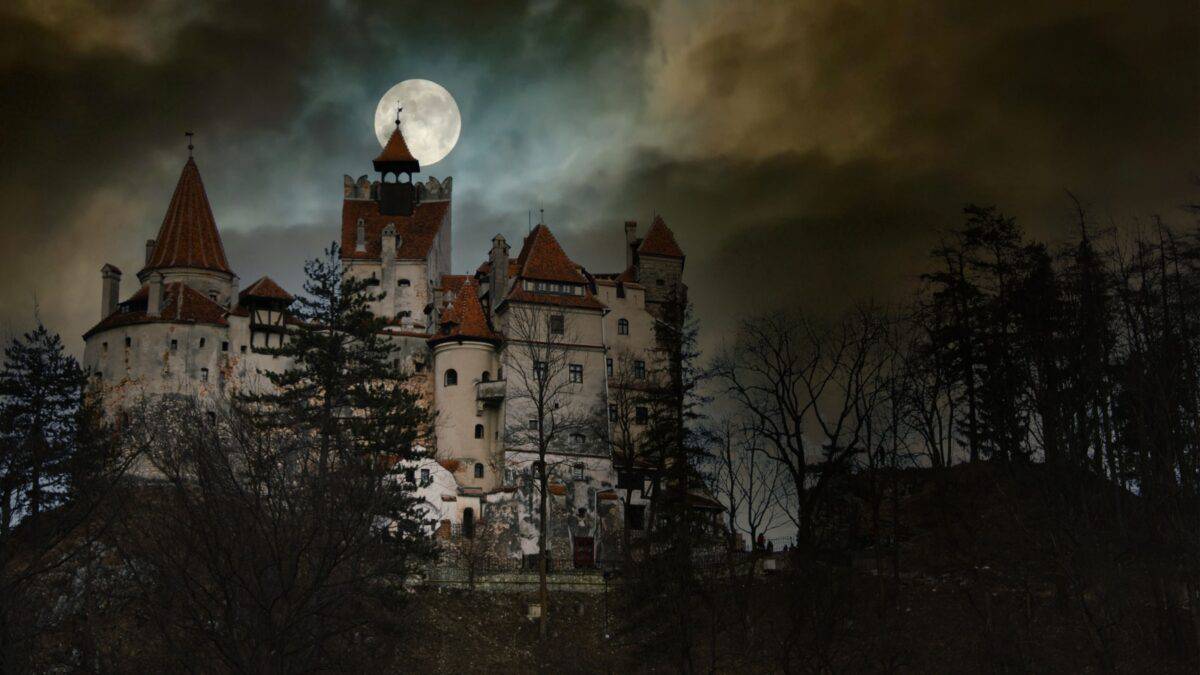
4. Bran Castle
Bran Castle was originally built as a fortress to thwart invaders but later became a luxurious royal home that is now a popular tourist attraction. It’s famous for two reasons:
First, it’s nicknamed Dracula’s Castle, thanks to its creepy-cool vibes and Bram Stoker’s imagination, even though Vlad the Impaler (Dracula’s inspiration) likely never stayed there. Second, it’s located in Transylvania, known for mountains, myths, and maybe even some mysterious vampire lore.
Read more about Bran Castle, oneof the Europe’s Haunted Castles
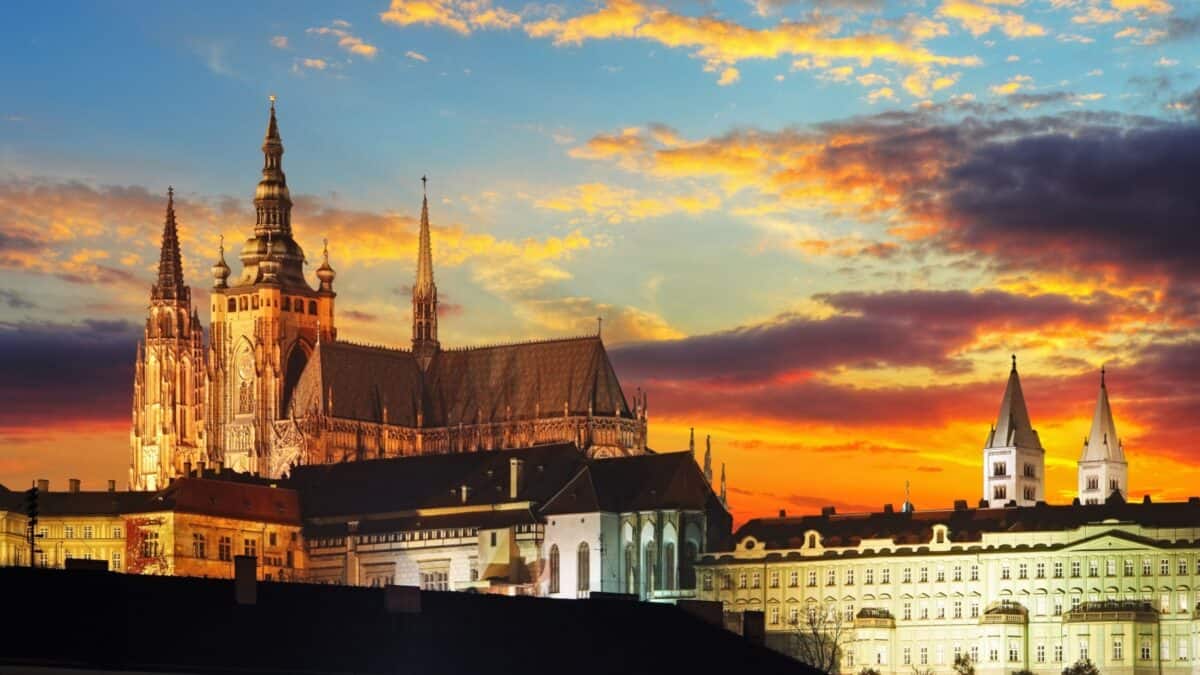
5. Prague Castle
This isn’t just any castle—it’s the world’s largest ancient castle, according to Guinness World Records ! Built in the 9th century, it has housed Bohemian kings, Holy Roman emperors, and now the Czech president. The breathtaking St. Vitus Cathedral sits at its heart, displaying its remarkable Gothic architecture.
The adorable Golden Lane sits on castle grounds and resembles a fairytale village lined with colorful, modest 16th-century houses originally built as residences for castle guards. z
Read more about Prague Castle one of the Gorgeous Castles You Should Visit
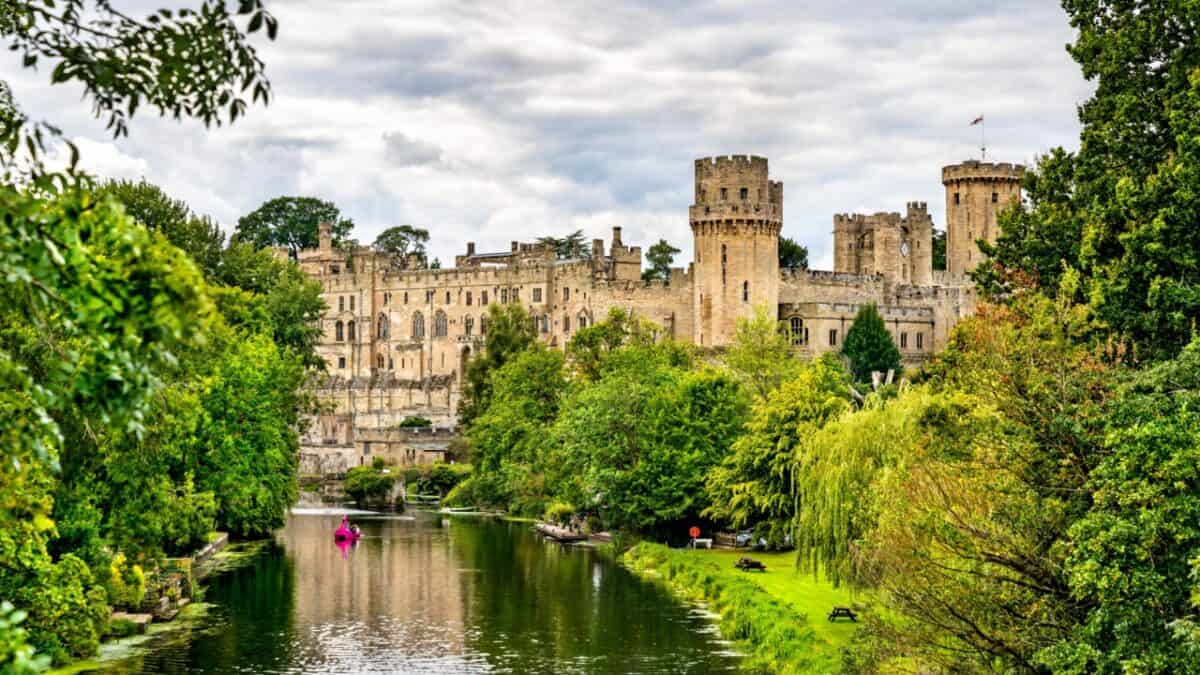
6. Warwick Castle
Warwick Castle, built during William the Conqueror’s reign in 1068, boasts over 1100 years of history. Located in Warwick, England, by the River Avon, its natural defenses made it nearly impenetrable.
Explore the Great Hall, climb towers for epic views, and enjoy live shows like jousting tournaments and huge birds of prey on display. For a thrill, don’t miss the spooky Warwick Castle Dungeon!
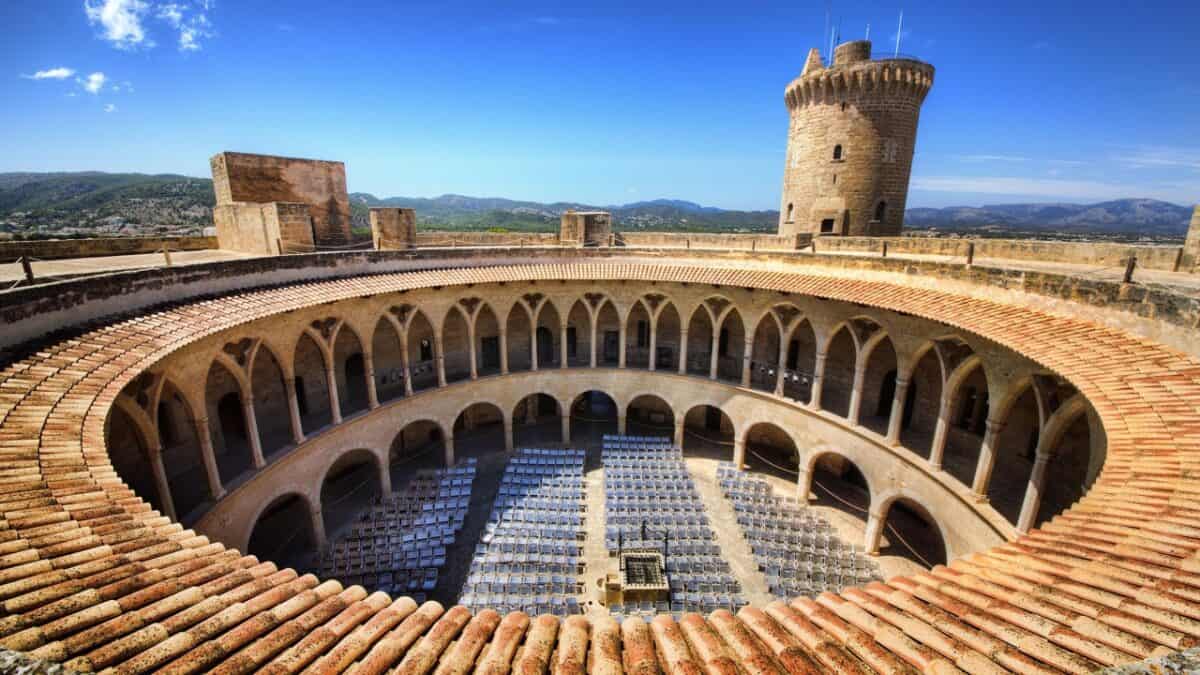
7. Bellver Castle
Bellver Castle, one of Europe’s rare circular castles, crowns a hilltop overlooking the island of Mallorca, Spain . Built in the 14th century by King James II of Majorca, it has served as a royal residence , prison, museum, and currency factory.
Bellver means beautiful view in Catalan, and the stunning vistas of Palma and its sparkling waters are definitely Instagram-worthy!
Read more about things to do in Palma Mallorca
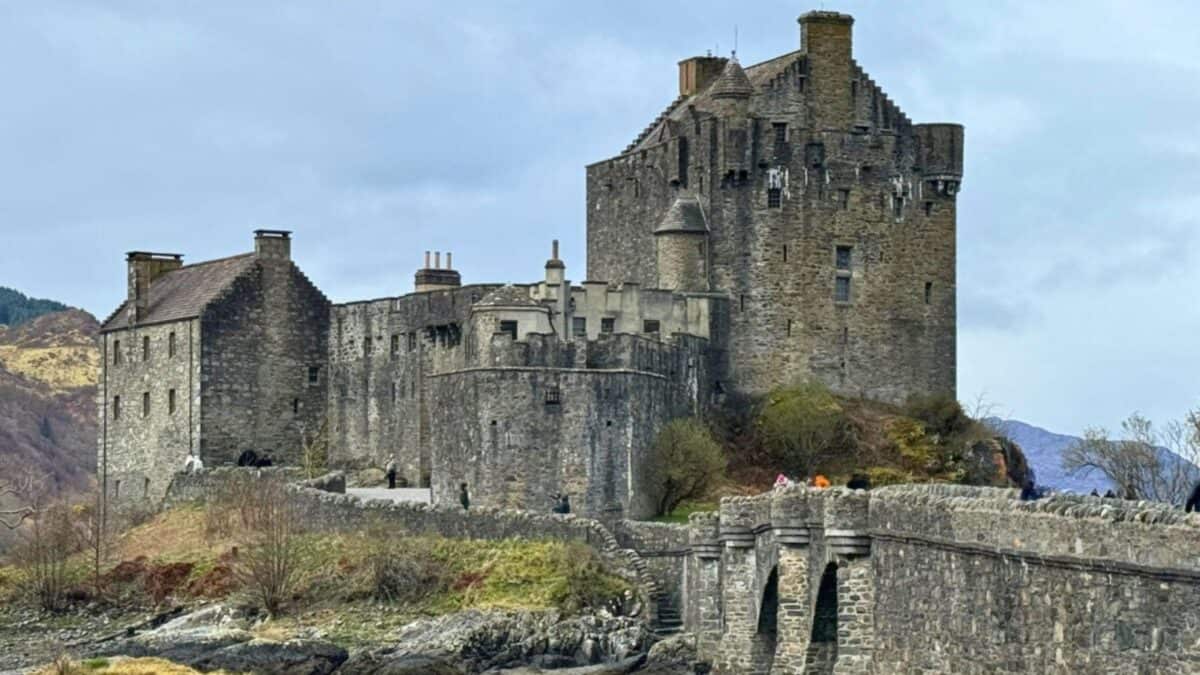
8. Eilean Donan Castle
If you remember the castle from the movies Highlander or The World Is Not Enough , then you won’t want to miss Eilean Donan in Scotland. Built in the 13th century, it witnessed Viking battles, clan feuds, and a Jacobite uprising.
Once in ruins, it was revived in the 20th century and is now Scotland’s most photographed castle. It’s an epic sight perched dramatically on an island where three lakes meet!
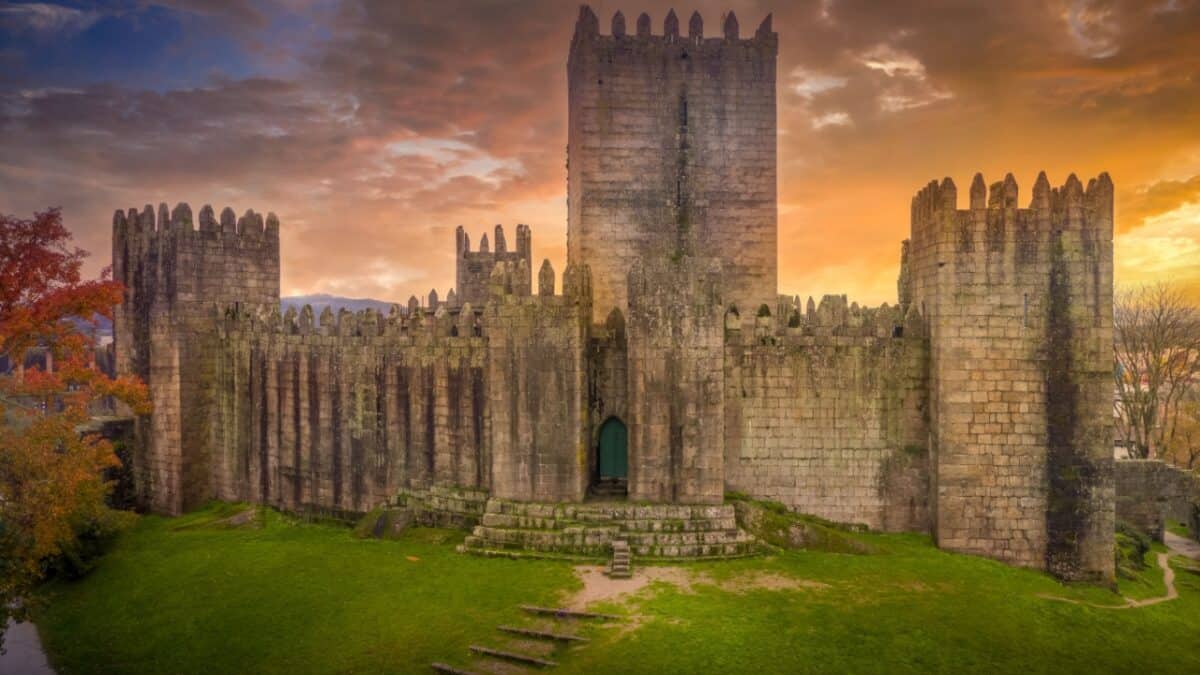
9. Castle of Guimarães
Constructed in the second half of 950 AD by Mumadona Dias, this Portuguese castle was a bold move to protect a nearby monastery from Viking and Moorish raids. Legend has it that it was the birthplace of Afonso Henriques, Portugal’s first king.
Today, this charming ruin boasts high walls, climbable towers, and ramparts where you can envision archers defending the fortress. A small exhibition narrates the castle’s history inside one of the towers.
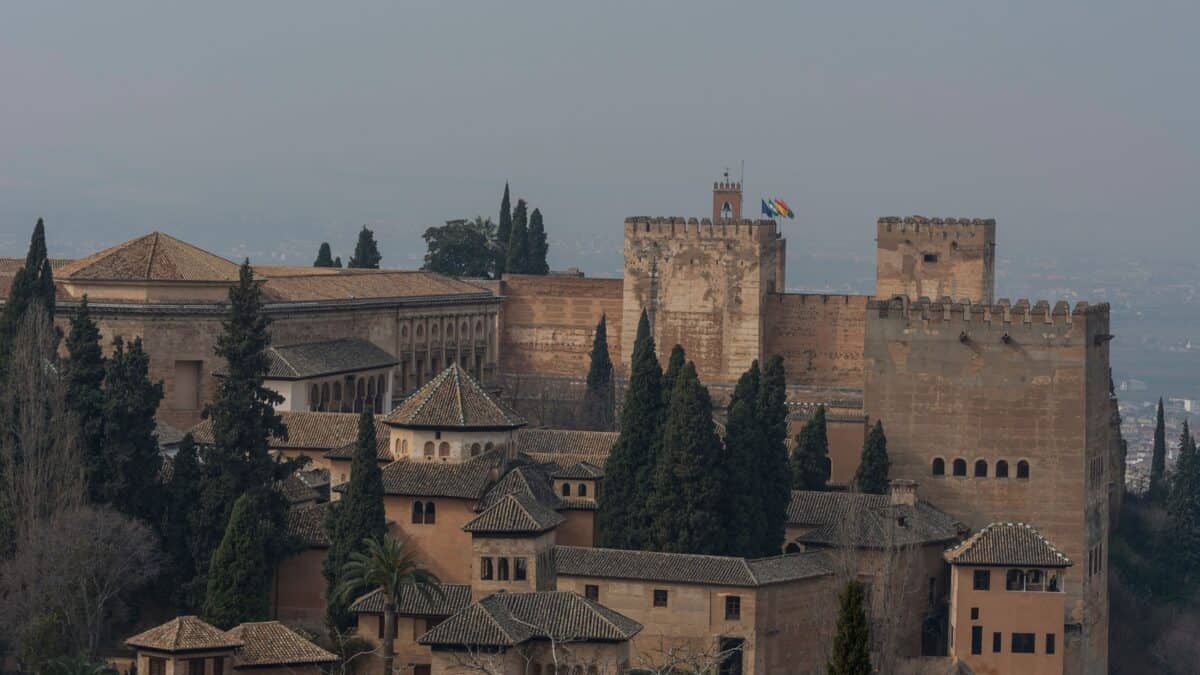
10. Alhambra de Granada
Whether you’re into art, history, or architecture, the Alhambra has it all. Named the Red Fortress for its striking towers and red walls, the Alhambra overlooks Granada, Spain, offering epic views.
Built-in the 13th century by Moorish sultan Muhammad I Ibn al-Ahmar, this self-contained city has palaces, gardens, and a military base. Tickets sell out quickly, so reserve in advance, especially in the summer!
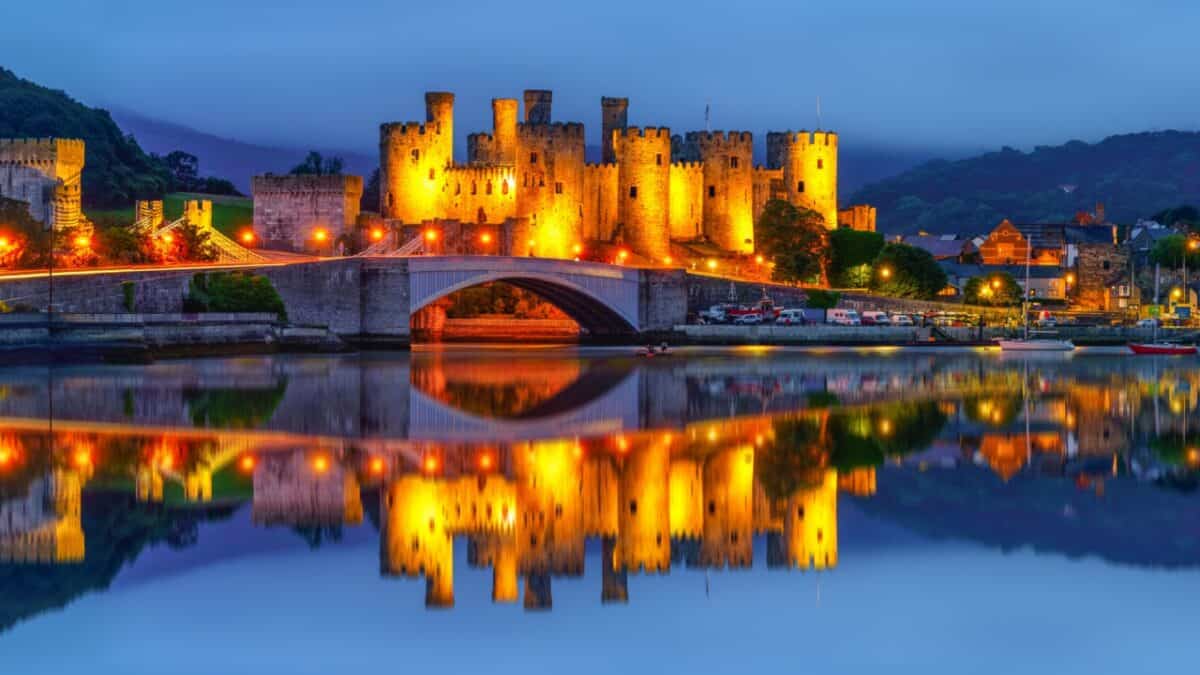
11. Conwy Castle
Built in the late 1200s, this castle on the coast of North Wales has been standing strong for over 700 years. King Edward I constructed it to conquer Wales and showcase his military power.
You can witness the palace’s history, explore the inner and outer wards, and imagine yourself as a brave knight defending the kingdom. Don’t miss the epic views from the battlements—you can see the whole town and even the mountains of Snowdonia in the distance!
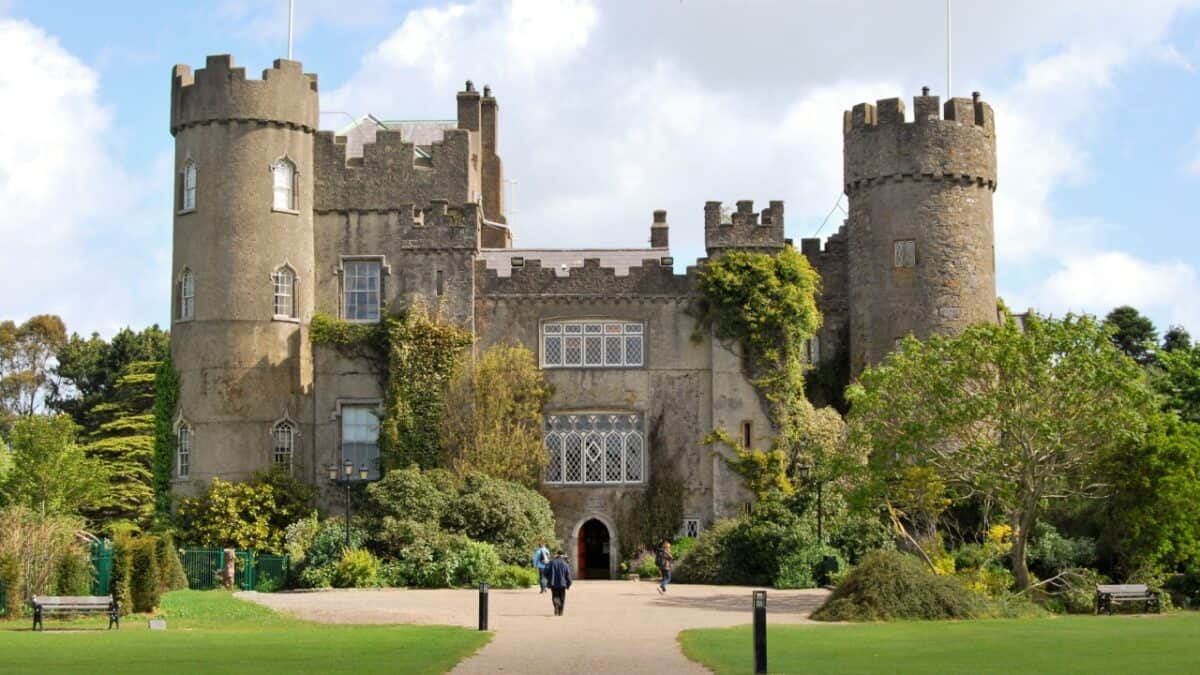
12. Malbork Castle
Poland’s Malbork Castle is not just any castle—it’s Europe’s largest fortress by land area! Built in the 13th century by the Teutonic Knights, it was their headquarters for nearly 150 years.
Explore the three main castles—the High, Middle, and Lower—each with its halls, chambers, and even an infirmary for the ill. Don’t miss the impressive defenses, including three rings of walls, towers, and a moat!

13. Wartburg Castle
Located on a hilltop overlooking Eisenach in Thuringia, Germany, Wartburg Castle has stood for almost a thousand years since its construction in 1067. It has been a part of pivotal moments in German history.
In 1521, German priest and founder of the Protestant Reformation Martin Luther sought refuge in the castle during his exile. Situated on a 410-meter cliff, the castle offers breathtaking countryside views.
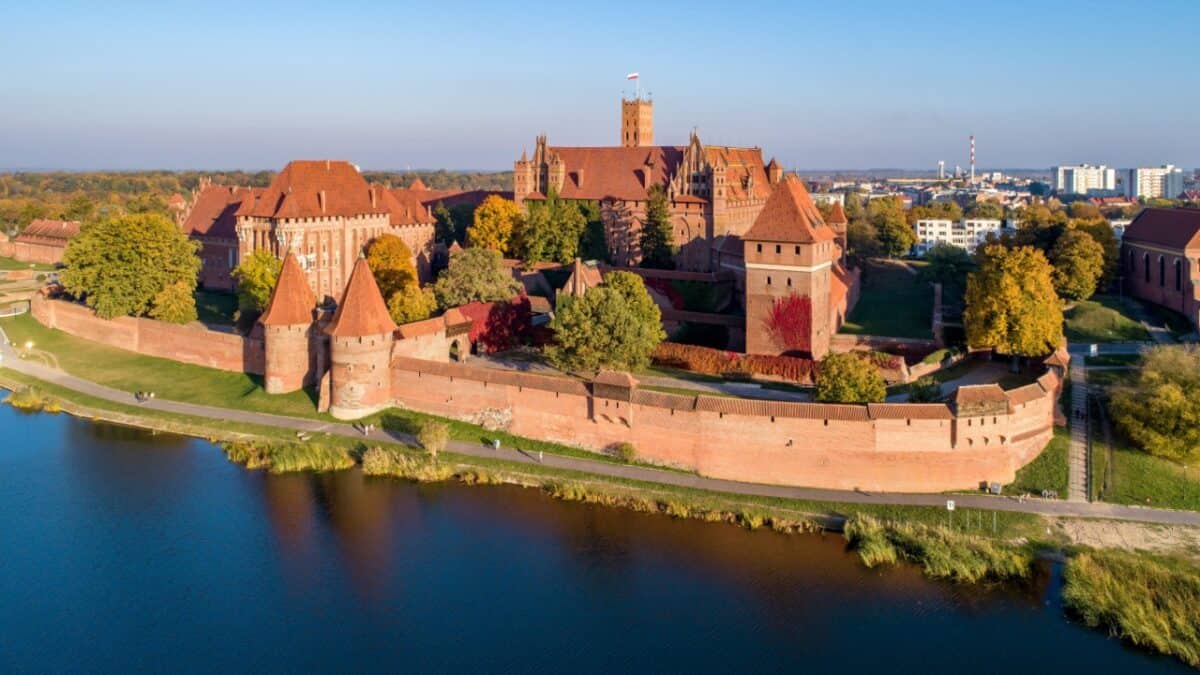
14. Malahide Castle
Malahide Castle, north of Dublin, Ireland , was built in 1174 by Richard Talbot, a knight who arrived with King Henry II. Originally a fortress and family home, it’s now a must-visit attraction.
Take a guided tour to see the Talbots’ rooms, furniture, and collections, and explore the beautiful parkland and walled garden with over 5,000 plant species worldwide, plus a glasshouse full of colorful butterflies.
Read more about Dublin Ireland, one of the European Airports for Budget Travelers
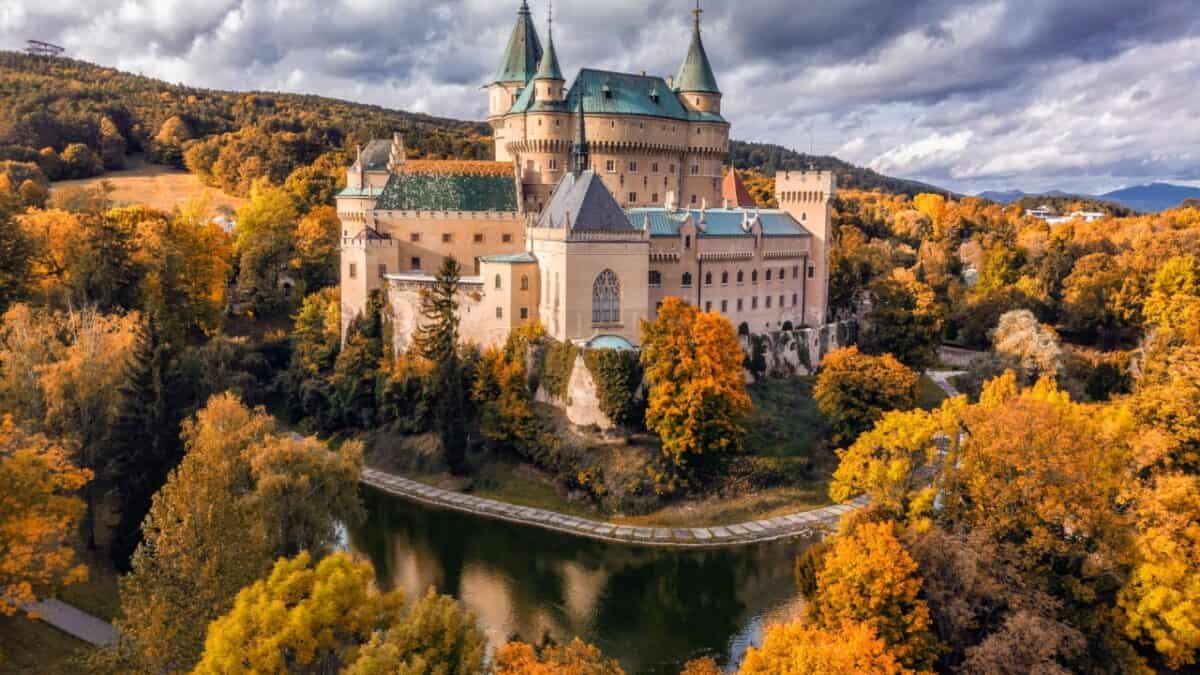
15. Bojnice Castle
Bojnice Castle is like a movie set for fantasy and fairytale films, but instead of Hollywood effects, it’s actually real! Built in the 12th century, it’s one of Slovakia’s medieval treasures that attracts tourists worldwide.
With its turrets, towers, and romantic atmosphere, it looks straight out of a storybook—perfect for families, history buffs, and anyone who secretly wishes they were a princess (or prince!). Explore grand halls adorned with suits of armor and fancy furniture, and peek out from towers for stunning views of the Slovakian countryside.
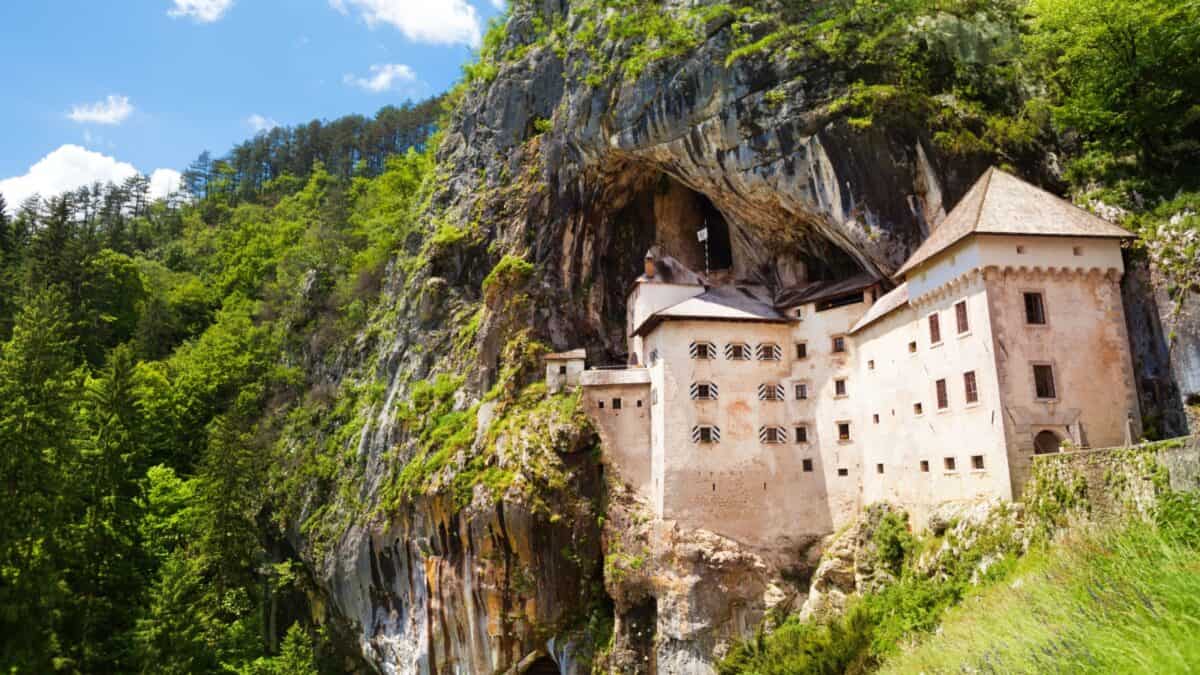
16. Predjama Castle
Predjama Castle, built in the 1200s in Slovenia, was originally constructed for defense and uniquely built right into a cave —a rare feature! Expanded by the Luegg family, the castle includes a knight’s hall, dining room, and chapel to explore.
The cave behind the castle is part of a larger system, and while you can’t explore it all, tours are available. Predjama Castle is about an hour from Ljubljana, the capital city of Slovenia, making it a perfect day trip to explore both the palace grounds and the cave.
Source: World Atlas , AFAR , and Auto Europe
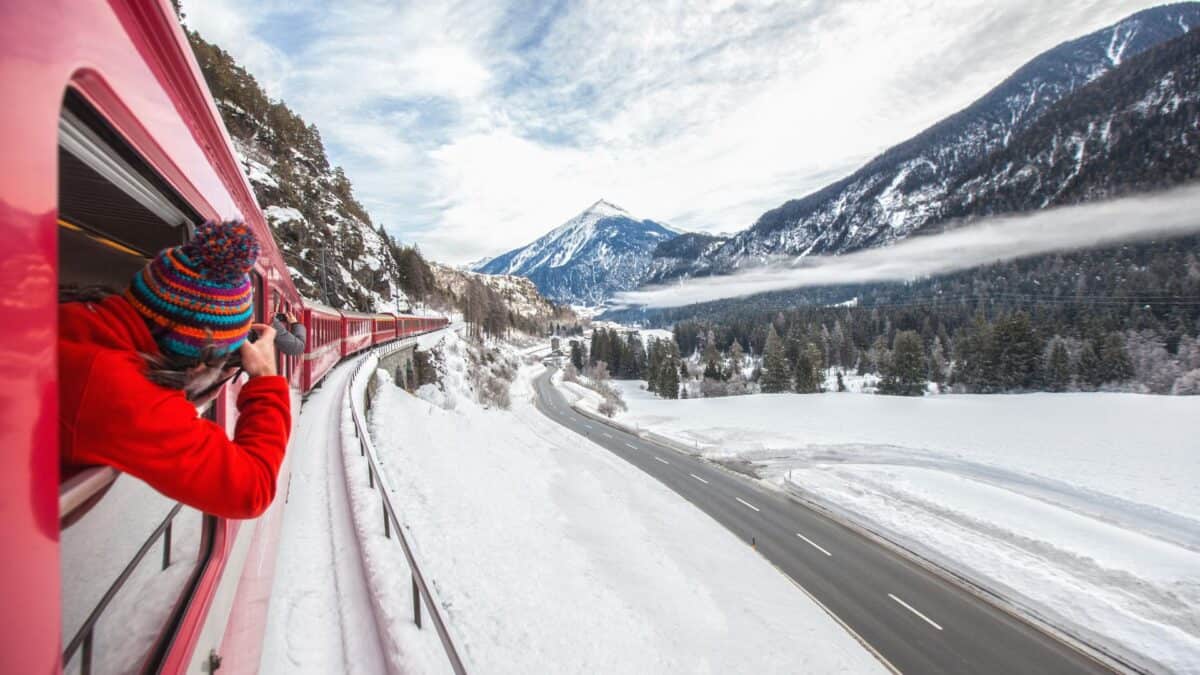
13 Unforgettable Train Rides Across Europe You Can’t Miss
Explore the stunning landscapes and rich cultures of Europe with these 13 unforgettable train rides that promise adventure at every turn—
Click here to discover them all!
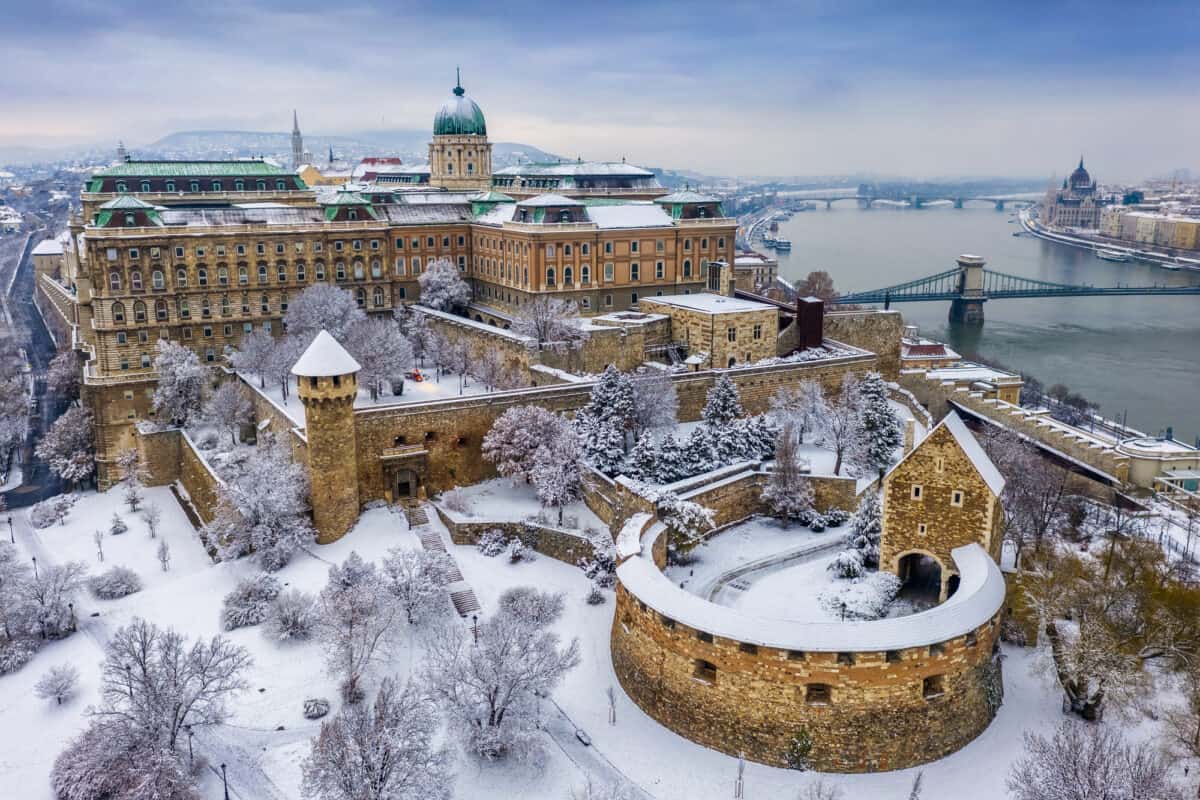
The 6 Best European Cities To Visit in Winter
Discover the charm and wonder of winter in Europe with our guide to the six best cities for a magical snowy getaway—
Click here to see where you should go next!
More for You
I’m an Economist: Here’s What a Trump Win in November Would Mean for the Tax Burden on the Poor
What Is Traction Control, And Should You Ever Turn It Off?
Social Security July Check 2024: When Will You Get Paid?
Super Bowl champion QB labels Jets' Aaron Rodgers as 'selfish and self-centered'
What Is the $1K Per Month in Retirement Rule?
Archaeologists Find 'Exciting' Colonial Artifact From Michigan Fort
The Supreme Court’s latest Jan. 6 ruling is a problem for Trump
What Is A Bobtail, And How Is It Different From A Semi Truck?
How to Spend 4 Days in Paris, According to Locals
13 Stretchy Mini Dresses That Are Sculpting Yet Tasteful
The 55 newest dog breeds recognized by the American Kennel Club
Human Ancestors May Have Bucked an Evolutionary Trend
Neil Gorsuch Cheers Supreme Court Placing 'Tombstone' on 40-Year Precedent
Scientists sound alarm about growing threat in Hawaiʻi: 'The decisions we make today should anticipate the flooding that we will have 50 years from now'
System in the central Atlantic strengthens into Tropical Storm Beryl. It poses a rare threat
We Found the Absolute Best Workout Shoes for All Kinds of Exercises
Where should you pull money from first in retirement? Here's the 'standard order' new US retirees need to know
EV Charging vs. Gas Prices: How Much Can You Really Save With an Electric Vehicle?
She just moved into a neighborhood of 3D printed homes in Texas — see what it's like inside
How Lake Mead Water Levels Have Changed So Far This Year

IMAGES
VIDEO
COMMENTS
"Many of us appreciate the unique importance of travel and exile for Islamic literature and thought. In English, however, we have had nothing to rival Touati's Islam and Travel in the Middle Ages, with its subtle, original argument, its elegant style, and its wide and profound coverage of original sources.Touati brings together a rich variety of topics and themes, with an underlying ...
Books. Islam and Travel in the Middle Ages. Houari Touati. University of Chicago Press, 2010 - History - 305 pages. In the Middle Ages, Muslim travelers embarked on a rihla, or world tour, as surveyors, emissaries, and educators. On these journeys, voyagers not only interacted with foreign cultures—touring Greek civilization, exploring the ...
Extract. In this eye-opening study of medieval Islamic travel (translated from the French original, Islam et voyage au Moyen Âge [2000]), Houari Touati argues that the scope and intent of this travel created the conceptual boundaries of the Muslim world, or Dār al-Islām. Through their movements, travelers defined "a political, religious, and cultural space" (p. 38), and thus travel was ...
Houari Touati: Islam and Travel in the Middle Ages. (Translated by Lydia G. Cochrane.) xiii, 304 pp. Chicago and London: University of Chicago Press, 2010. £35.50. ISBN 978 0 226 80877 2. - Volume 74 Issue 3
The Medieval Islamic Empire was a collection of regions in which Islam was practised. From the mid-600s, the Islamic Empire spread throughout the Middle East, west across North Africa and Spain ...
The spread of Islam to South Asia is because of the Delhi Sultanate and the Mughal Empire. The North Africans were captured by the Turks which in turn caused the Spread of Islam. The Europe Continent was not very popular to have Islam ruling but the Turks had also captured places like Italy. ( 5 votes) Upvote.
The Spread of Islam and its Relationship to Medieval EuropeGrowth of Islam.When Islam first emerged in Arabia during the mid-seventh century, there was little indication that within 150 years the movement would come to dominate the entire Middle East, as well as northern Africa and Spain. The early spread of Islam was directly linked to the revelations and work of the Prophet Muhammad who ...
In the Middle Ages, a varied and vibrant Islamic culture flourished in all its aspects, from religious institutions to legal and scientific endeavors. Lassner, Reisman, and Bonner detail how all three montheist traditions are linked to the same sacred history. They trace the most current scholarship on the Arabian background to Islam, the ...
In the Middle Ages, Muslim travelers embarked on a rihla, or world tour, as surveyors, emissaries, and educators. On these journeys, voyagers not only interacted with foreign cultures—touring Greek civilization, exploring the Middle East and North Africa, and seeing parts of...
Islam And Travel In The Middle Ages - gny.salvationarmy.org WEBlandscape encouraged travel. And yet, Verdon points out, the world of the Middle Ages was one of unceasing movement. Islam in the Middle Ages - Jacob Lassner 2009-11-19 In the Middle Ages, a varied and vibrant Islamic culture flourished in all its aspects, from religious
They also built monasteries all over the place, which became places for people to stop along their travel and mingle with fellow Sufis. Most were for men, but there were a few for female worshippers. ... and Society in the Islamic World of the Middle Ages. Princeton, N.J.: Program in Near Eastern Studies, Princeton University, 1981. Valérian ...
A Christian and a Muslim playing chess, illustration from the Book of Games of Alfonso X (c. 1285).. During the High Middle Ages, the Islamic world was at its cultural peak, supplying information and ideas to Europe, via Al-Andalus, Sicily and the Crusader kingdoms in the Levant.These included Latin translations of the Greek Classics and of Arabic texts in astronomy, mathematics, science, and ...
Religious Travel in the Global Middle Ages. Pilgrimage, proselytising, and religious study have been major factors for human mobility throughout history, and were both cause and consequence of the intense trans-regional connectivity characterising the "Global Middle Ages". Involving people of different genders and social backgrounds, religious ...
Medieval Europeans were fascinated by the lands that lay beyond their own continent. Josephine Livingstone looks at the real and imaginary travels of explorers and tradesman through works including The Book of John Mandeville, The Travels of Marco Polo and medieval maps. From a 21st-century perspective - in an age of air travel and high-speed ...
The Arab geographer Muhammad al-Idrisi produced his medieval atlas, Tabula Rogeriana or The Recreation for Him Who Wishes to Travel Through the Countries, in 1154.He incorporated the knowledge of Africa, the Indian Ocean and the Far East gathered by Arab merchants and explorers with the information inherited from the classical geographers to create the most accurate map of the world in pre ...
Houari Touati. Islam and Travel in the Middle Ages. Translated by Lydia G. Cochrane. Chicago: University of Chicago Press, 2010. xiv + 305 pages, appendix, glossary, bibliography. Cloth US$60.00 ISBN 978-0-22680877-2. - Volume 48 Issue 1-2
Things that improved the quality of life, like science and technology, were encouraged and welcomed. These included practical things like navigational aids for travellers, geographical maps, medical knowledge, ways of measuring and calculating, and tools for agriculture. The use of paper and books was very important in sharing and promoting ...
Hospitals, universities, coffee and even the predecessors of modern violins and cameras, for example, were all pioneered during the Islamic Golden Age. Here are 9 Muslim inventions and innovations of the medieval period. 1. Coffee. Yemen is where the ubiquitous dark bean brew has its origins from around the 9th century.
Introduction. Muslim trade in the Mediterranean world was strikingly different in the later medieval period than it had been in earlier centuries. During the fifth/eleventh century, control of Mediterranean shipping and commerce began to shift from Muslim to Christian hands as a result of crusade, conquest and the growth of the European economy.
The Islamic Golden Age was a period of scientific, economic and cultural flourishing in the history of Islam, traditionally dated from the 8th century to the 13th century.. This period is traditionally understood to have begun during the reign of the Abbasid caliph Harun al-Rashid (786 to 809) with the inauguration of the House of Wisdom, which saw scholars from all over the Muslim world flock ...
Islam began in the Arabian peninsula, and the first Islamic empires and had a distinctly Arab character. ... SO, in the same way that Christian Kingdoms in Europe in the Middle Ages collected higher taxes on Jews than on Christians, Medieval Muslim societies collected higher taxes on non-Muslim people within their borders. In both cases, it was ...
Travel and Exploration in the Middle Ages was published in Volume 3 on page 1680.
Explore the three main castles—the High, Middle, and Lower—each with its halls, chambers, and even an infirmary for the ill. Don't miss the impressive defenses, including three rings of ...